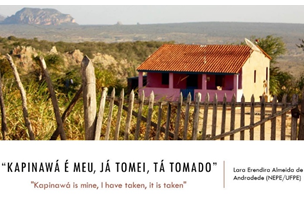"Kapinawá is mine, I have taken, it is taken"
Keywords:
kapinawá identity, Territory, Cosmology.Abstract
This essay brings together photographs taken over the last four years, the period of my work as an anthropologist and educator with the indigenous people Kapinawá and context in which developed master's research in anthropology.
I decided to develop this study together with Kapinawá after a process of political mobilization that occurred in 2011, in which indigenous people promoted the occupation of a farm that had invaded their territory in the late 1970s. This action claimed land property regularization that still has no administrative measures. Moreover this land is part of a protected area, the Catimbau National Park. The title “Kapinawá is mine, I have taken, it is taken” came from a piece of music sung by singers from local Samba de coco, which expresses the process forward group's resistance to attacks against its territory.
The Kapinawá people has a population of about 3.700 people (FUNASA, 2009), and the inhabited territory located between three municipalities of Pernambuco: Buíque, Tupanatinga and Ibimirim. Those located between two different regions: Agreste and Sertão. Nowadays there are thirty villages, most of them located along the two main rivers that cross the territory: the Monkey Creek and the Creek Catimbau.
From an emic point of view this land is classified in three areas according social organization of family groups. This classification is the primary tool for ethnic identity recognition. In this sense, there is a "demarcated area", for which the claim process started in the late 1970s, the "new area", claimed at the end of the 1990s. Finally, there are some families that began the struggle only at the end of the first decade of the 2000s, the so-called "villages of Ibimirim".
During my fieldworks, older people told me about the relevance of this enchanted environment. This contribute to forge “caboclo” identity and to identify which are “things of caboclo”.
The stories are present in family daily lives and deal with environment, eating habits and the knowledge they have of their territory. Also, stories refer to novenas, benditos, to sambas de coco and other sambas that are the basic rhythms for ritual as toré and toantes. Those rhythms are part of a web that involves rituals, economic and political relations.
All these aspects are fundamentals for the understanding of kapinawá identity. This research therefore portray some pieces of this cosmological universe, composed by people, places and objects.
Credits:
Author: Lara Erendira Almeida de Andrade (Nepe/UFPE | GETI/UFPB)
Photographs:Lara Erendira Almeida de Andrade
Direction, image editing and text: Lara Erendira Almeida de Andrade

Downloads
Published
Issue
Section
License

This work is licensed under a Creative Commons Attribution-NonCommercial 4.0 International License.
Direitos Autorais para trabalhos audiovisuais publicados na AntHropológicas Visual sã licenciados para uma licenca Creative Commons 4.0 BY-NC.
